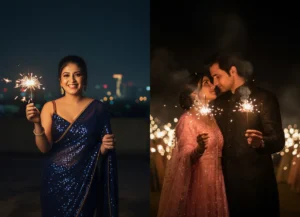Create Stunning Characters, Textures, Models, and Environments to Enhance Your Game’s Visual with AI!
Game development is an exciting but challenging process, and one of the most time-consuming aspects is asset creation.
AI image generator offers a solution to this problem by enabling developers and designers to create a wide variety of game assets quickly and efficiently.
Designing characters, textures, objects, environments, or weapons, AI provides a powerful toolset for generating visually stunning assets.
Here you will get 30 ideogram.ai prompts for creating different types of game assets, offer tips and tricks for using the platform effectively, and explain why ideogram.ai can be a better option than Midjourney for game developers. This guide will give you everything you need to jump-start your game asset creation process.
The game 2D elements you create with AI are immediately usable. But in the case of 3D elements, you should only use them as an inspiration or reference image.
Ideogram AI can generate base models that can later be refined using game development software for rigging, animation, or further texturing.
Also Read:
Why Ideogram Can Be Better Than Midjourney for Game Asset Creation?
With tools like Midjourney already popular, you might be wondering why ideogram.ai is worth considering. Here’s why Ideogram AI can be a superior option for game developers:
- Free to Use: Unlike some other AI image generators, ideogram.ai offers its features for free, making it accessible to everyone.
- Designed for Usability: Ideogram AI offers easy-to-use interfaces and settings optimized for creating usable assets directly from the prompts without requiring too much tweaking.
- Specialized for Game Development: While Midjourney is known for creating visually stunning images, ideogram.ai focuses more on practicality, offering a wide range of outputs.
You can also add your desired render engine like Unity render or Unreal render at the end of the prompts to tell the AI that how you want your objects to render, to make it more familiar with the game environments
1. Creating Game Characters with Ideogram AI
Great game characters need to be visually distinct and designed with usability in mind.
For optimal character generation, make sure to adjust your ideogram AI settings and the prompt to match the style you want. Focus on the resolution, lighting, and texture details to ensure your character integrates well into your game engine.
Character Design Prompts
Here are five prompts to help you create a variety of characters:

- Prompt 👉 Fantasy Warrior in Armor, battle-ready, with glowing sword, high detail, dark medieval style
(A fierce, battle-ready fantasy warrior perfect for RPG or action games. This asset can be used as a playable character or enemy NPC in fantasy-themed games.)
- Prompt 2👉 Sci-Fi alien species, humanoid, advanced technology suit, blue skin, glowing eyes
(A humanoid alien character with a futuristic look, suitable for sci-fi settings. Use this character in space exploration or alien invasion games.)
- Prompt 3👉 Cartoon-style hero with a cape, bold colors, oversized eyes, cell-shading
(A hero character with exaggerated features and bright colors, ideal for cartoon or comic-style games. Best for 2D platformers or mobile games.)
- Prompt 4👉 Steampunk adventurer, mechanical limbs, worn-out clothes, sepia tones
(A rugged steampunk explorer with mechanical features. This asset fits well in dystopian, alternate history, or adventure games.)
- Prompt 5👉 Medieval knight, full armor, carrying a banner, intricate metalwork
(A highly detailed medieval knight character. Perfect for historical, fantasy, or strategy games where medieval combat is key.)
2. Designing Game Textures with Ideogram AI
Textures give life to environments and objects in games, creating depth and realism.
Make sure to adjust your prompt to include texture-specific keywords such as “grainy,” “smooth,” or “detailed” to get the right output. Use ideogram.ai’s resolution settings to ensure textures are high enough quality for in-game use.
Texture Design Prompts
Here are five prompts to create a wide variety of game textures:

- Prompt 1👉 Photorealistic grass texture, slightly uneven, rich green colors, wet, detailed
(A lifelike grass texture that’s perfect for outdoor environments. Ideal for open-world games, park settings, or countryside levels.)
- Prompt 2👉 Rusty metallic surface, peeling paint, industrial, rough texture, high contrast
(A worn-out metal texture that adds realism to industrial settings. Perfect for post-apocalyptic or dystopian environments.)
- Prompt 3👉 Wooden plank floor texture, hand-painted style, soft lighting, warm tones
(A stylized wooden floor texture with a painterly aesthetic. Best suited for cozy, indoor environments or stylized adventure games.)
- Prompt 4👉 Alien surface texture, glowing green veins, organic material, bioluminescent
(An alien texture that looks alive with glowing veins and a unique organic feel. Use in alien landscapes or futuristic science fiction environments.)
- Prompt 5👉 Sci-Fi computer console texture, holographic interface, neon colors, high-tech
(A futuristic console interface texture for control panels. Great for space stations, control rooms, or futuristic tech environments.)
3. Creating Usable Game Objects in Ideogram AI
Game objects can range from simple items like keys and potions to more complex structures like vehicles or gadgets.
Use object-specific keywords such as “metallic,” “wooden,” or “ancient” to customize your outputs to the game’s environment and narrative.
Object Creation Prompts
Here are five prompts to generate essential game objects:

- Prompt 1👉 Ancient magical sword, glowing runes, detailed hilt, worn blade
(A magical sword with glowing runes, perfect for high-fantasy games. Ideal for role-playing games or action-adventure games.)
- Prompt 2 👉 Futuristic drone, sleek metallic design, hovering, small size, surveillance mode
(A small, high-tech drone designed for surveillance or combat. Use in sci-fi or military-themed games.)
- Prompt 3👉 Steampunk clock, brass gears, intricate details, slightly tarnished
(A detailed steampunk clock with visible gears and a vintage look. Fits in adventure, puzzle, or alternate-history games.)
- Prompt 4👉 Post-apocalyptic survival kit, worn backpack, makeshift tools, rough textures
(A rugged survival kit, perfect for a post-apocalyptic setting. Use in survival or adventure games.)
- Prompt 5👉 Sci-Fi energy shield generator, glowing blue core, sleek design, minimalistic
(A futuristic shield generator with a glowing energy core. Perfect for science fiction games or futuristic settings.)
4. Crafting 2D and 3D Models Using Ideogram AI
Game developers often choose between 2D and 3D models based on the style and complexity of the game. 2D models are primarily flat and used in side-scrolling games, mobile apps, or indie games with a hand-drawn or pixelated aesthetic. On the other hand, 3D models bring depth, dimension, and realism, making them suitable for immersive and detailed environments like those in RPGs or action games.
To create 2D or 3D models with ideogram.ai, you need to optimize your prompts according to the desired style. For 2D assets, including terms like “flat,” “cartoon,” or “pixelated” to guide the AI toward producing 2D images.
For 3D assets, emphasize details like “realistic lighting,” “depth,” and “perspective” to ensure that the generated assets have a three-dimensional appearance.
Make sure to adjust the resolution and output quality in ideogram.ai’s settings for better integration into game engines like Unity or Unreal Engine.
Ideogram AI can generate base models that can later be refined using game development software for rigging, animation, or further texturing.
Model Design Prompts
Here are five prompts to create a variety of 2D and 3D models:

- Prompt 1👉 Low-poly 3D model of a fantasy village, basic shapes, bright colors, simple textures
(A low-poly, vibrant fantasy village. Ideal for casual or mobile games requiring simple, low-poly models.)
- Prompt 2👉 3D futuristic vehicle model, sleek design, glowing hover engines, metallic texture, cyberpunk style
(A sleek, hover-enabled 3D vehicle model that fits perfectly into a cyberpunk or futuristic game setting. Use this model in open-world sci-fi games or racing games with futuristic environments.)
- Prompt 3👉 2D cartoon-style character, young wizard, oversized hat, spellbook, bold outlines, hand-drawn style
(A hand-drawn 2D cartoon character of a young wizard with exaggerated features. Great for children’s games, casual games, or whimsical mobile adventures with a focus on a light-hearted art style.)
- Prompt 4👉 3D model of a dragon, scaly texture, large wingspan, fire-breathing, realistic lighting
(A highly detailed 3D dragon model with a realistic scaly texture and powerful wings. Perfect for high-fantasy games or action RPGs with mythical creatures and large-scale combat.)
- Prompt 5👉 2D low-poly landscape, bright colors, blocky mountains, simple shading, stylized look
( A 2D low-poly landscape featuring mountains and a vibrant color palette, with simple, blocky elements. Ideal for minimalist or mobile games that require stylized, low-poly art, offering a clean and modern aesthetic.)
5. Designing Game Environments with Ideogram AI
Environments serve as the backdrop for the entire player experience, creating the atmosphere and mood of the game. From lush forests to industrial cities, well-designed game environments immerse players in the game world, affecting both gameplay and storytelling.
To create environments, use ideogram robust landscape and object rendering capabilities. Include descriptive keywords like “lush,” “desolate,” or “futuristic” to tailor the output to your game’s specific world-building needs.
You can also specify lighting conditions like “overcast,” “sunset,” or “nighttime” to further refine the atmosphere.
Environment Creation Prompts
Here are five prompts for creating diverse game environments:

- Prompt 1👉 Dense forest environment, misty, tall trees, detailed foliage, beams of sunlight through the canopy
(A detailed forest environment with rich foliage and beams of sunlight. Ideal for RPGs or adventure games with exploration elements.)
- Prompt 2👉 Abandoned cityscape, crumbling buildings, overgrown with plants, post-apocalyptic, gritty atmosphere
(A post-apocalyptic urban environment featuring dilapidated buildings and overgrown flora. Use this for survival games or dystopian settings where the world has fallen into ruin.)
- Prompt 3👉 Alien desert landscape, purple sand, bioluminescent plants, two suns in the sky, extraterrestrial
(A surreal, otherworldly desert with alien flora and double suns. Perfect for sci-fi games where alien planets are a key setting.)
- Prompt 4👉 Futuristic city at night, neon lights, flying cars, towering skyscrapers, cyberpunk aesthetic
(A neon-lit, high-tech futuristic city with skyscrapers and flying vehicles, perfect for a cyberpunk environment. Use in sci-fi or cyberpunk games that explore urban environments with a high level of technological advancement.)
- Prompt 5👉 Medieval castle interior, stone walls, grand hall, tapestries, flickering torchlight, royal aesthetic
(A grand medieval castle interior with stone walls and royal decorations. Best suited for fantasy RPGs or adventure games where players explore ancient, regal structures.)
6. Creating Weapons for Game Development with Ideogram AI
Weapons are a core part of many games, whether you’re developing an FPS, an RPG, or a strategy game. AI can help you generate custom weapons that match the tone and style of your game, from realistic firearms to enchanted swords.
When generating weapons, be specific in your prompts to ensure the AI produces a design that’s both unique and functional. Keywords like “futuristic,” “ancient,” or “magical” will guide the AI toward the right aesthetic. Also, consider specifying materials like “metallic,” “crystalline,” or “wooden” to further refine the weapon’s look.
Weapon Creation Prompts
Here are five prompts for creating a range of different weapon types:

- Prompt 1👉 Futuristic plasma rifle, glowing blue core, sleek metallic design, advanced tech
(A sleek, high-tech plasma rifle with glowing energy components. Ideal for sci-fi shooters or action games that feature futuristic combat.)
- Prompt 2👉 Ancient enchanted sword, glowing runes on the blade, ornate hilt, fantasy design
(A mystical sword with glowing runes and an intricately designed hilt. Perfect for high-fantasy games where magic weapons play a central role.)
- Prompt 3👉 Post-apocalyptic makeshift weapon, rusty metal, duct-taped handle, jagged edges
(A rugged, improvised weapon made from scavenged materials. Use this in survival or post-apocalyptic games where resources are scarce.)
- Prompt 4👉 Medieval longbow, wooden frame, leather grip, taut bowstring, detailed engravings
(A detailed, realistic longbow with engravings and a sturdy wooden frame. Ideal for historical games or medieval settings where archery is a key mechanic.)
- Prompt 5👉 Dual-bladed energy staff, glowing tips, sleek metallic shaft, futuristic martial weapon
(A futuristic staff weapon with glowing energy blades at both ends. Perfect for sci-fi action games that feature melee combat with high-tech weaponry.)
Takeaways
“By leveraging ideogram.ai’s power and flexibility, you can create an incredible variety of game assets for characters, textures, objects, environments, models, and weapons. Whether you’re working on a small indie game or a large one, these prompts and tips will help you produce high-quality assets quickly and efficiently.
In addition, ideogram.ai’s free-to-use platform and specialized tools for game asset creation make it a strong contender for developers, offering more practical and accessible solutions compared to other AI tools like Midjourney. With these prompts, you can begin building your game worlds right away and bring your creative vision to life with ease.”
Share your AI creations on social media using the hashtags #Aiartz and #ArtzLab and tag me on Instagram (ai.artz70) and Twitter/X (ai_artz70).





Cool